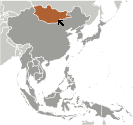World Atlas: Mongolia. On this page you can see the map, country flag and many detailed information about the people, history and economy of Mongolia.

Here you can find online selected information about the geography, inhabitants, government, economy and history of Mongolia. Included are selected statistics, an overview map and the detailed map of Mongolia. But let's start with the flag of Mongolia here:
Mongolia - Overview:
What you should know about Mongolia? Let's start with this: The Mongols gained fame in the 13th century when under Chinggis Khaan they established a huge Eurasian empire through conquest. After his death the empire was divided into several powerful Mongol states, but these broke apart in the 14th century. The Mongols eventually retired to their original steppe homelands and in the late 17th century came under Chinese rule. Mongolia declared its independence from the Manchu-led Qing Empire in 1911 and achieved limited autonomy until 1919, when it again came under Chinese control. The Mongolian Revolution of 1921 ended Chinese dominance, and a communist regime, the Mongolian People’s Republic, took power in 1924. The modern country of Mongolia, however, represents only part of the Mongols' historical homeland; today, more ethnic Mongolians live in the Inner Mongolia Autonomous Region in the People's Republic of China than in Mongolia. Since the country's peaceful democratic revolution in 1990, the ex-communist Mongolian People's Revolutionary Party (MPRP) - which took the name Mongolian People’s Party (MPP) in 2010 - has competed for political power with the Democratic Party (DP) and several other smaller parties, including a new party formed by former President Enkhbayar, which confusingly adopted for itself the MPRP name. In the country's most recent parliamentary elections in June 2016, Mongolians handed the MPP overwhelming control of Parliament, largely pushing out the DP, which had overseen a sharp decline in Mongolia’s economy during its control of Parliament in the preceding years. Mongolians elected a DP member, Khaltmaa Battulga, as president in 2017.
Geography of Mongolia
 Where on the globe is Mongolia? The location of this country is Northern Asia, between China and Russia. Total area of Mongolia is 1,564,116 sq km, of which 1,553,556 sq km is land. So this is very large country. How could we describe the terrain of the country? This way: vast semidesert and desert plains, grassy steppe, mountains in west and southwest; Gobi Desert in south-central. The lowest point of Mongolia is Hoh Nuur 560 m, the highest point Nayramadlin Orgil (Khuiten Peak) 4,374 m. And the climate is desert; continental (large daily and seasonal temperature ranges).
Where on the globe is Mongolia? The location of this country is Northern Asia, between China and Russia. Total area of Mongolia is 1,564,116 sq km, of which 1,553,556 sq km is land. So this is very large country. How could we describe the terrain of the country? This way: vast semidesert and desert plains, grassy steppe, mountains in west and southwest; Gobi Desert in south-central. The lowest point of Mongolia is Hoh Nuur 560 m, the highest point Nayramadlin Orgil (Khuiten Peak) 4,374 m. And the climate is desert; continental (large daily and seasonal temperature ranges).
Inhabitants of Mongolia
Let's take a look how many people live in Mongolia. The number is: 3,068,243. So this is not very populous country. Who lives here? Khalkh 81.9%, Kazak 3.8%, Dorvod 2.7%, Bayad 2.1%, Buryat-Bouriates 1.7%, Zakhchin 1.2%, Dariganga 1%, Uriankhai 1%, other 4.6% (2010 est.). What are the languages in Mongolia? Mongolian 90% (official) (Khalkha dialect is predominant), Turkic, Russian (1999). And the religions: Buddhist 53%, Muslim 3%, Shamanist 2.9%, Christian 2.2%, other 0.4%, none 38.6% (2010 est.). How old are the people in average? 28.3 years. We have to add that this number is the median - so one half of the people is older than this, one half is younger. And what is their life expectancy (at birth)? This: 69.9 years. Where the people live in Mongolia? Here: sparsely distributed population throughout the country; the capital of Ulaanbaatar and the northern city of Darhan support the highest population densities. The major urban areas of Mongolia are: Ulaanbaatar (capital) 1.377 million (2015).
Government and Economy of Mongolia
The capital of Mongolia is Ulaanbaata and the government type semi-presidential republic. Let's take a look at the administrative divisions - 21 provinces (aymguud, singular - aymag) and 1 municipality (singular - hot); Arhangay, Bayanhongor, Bayan-Olgiy, Bulgan, Darhan-Uul, Dornod, Dornogovi, Dundgovi, Dzavhan (Zavkhan), Govi-Altay, Govisumber, Hentiy, Hovd, Hovsgol, Omnogovi, Orhon, Ovorhangay, Selenge, Suhbaatar, Tov, Ulaanbaatar, Uvs. Regarding the economy of Mongolia, important industrial products are construction and construction materials; mining (coal, copper, molybdenum, fluorspar, tin, tungsten, gold); oil; food and beverages; processing of animal products, cashmere and natural fiber manufacturing. Important agricultural products are wheat, barley, vegetables, forage crops; sheep, goats, cattle, camels, horses. The most important export commodities are copper, apparel, livestock, animal products, cashmere, wool, hides, fluorspar, other nonferrous metals, coal, crude oil and the most important export partners are China 84.1%, UK 6.8% (2016). The most important import commodities are machinery and equipment, fuel, cars, food products, industrial consumer goods, chemicals, building materials, cigarettes and tobacco, appliances, soap and detergent and the most important import partners are China 33.2%, Russia 25.6%, South Korea 8.6%, Japan 7% (2016). How rich is Mongolia and how rich are people in this country? The most important number here is GDP per capita (PPP): $12,600 (2017 est.). This is quite good. Let's add that this means Gross Domestic Product per person, which is recalculated with respect to the relative cost of local goods and services. And one more important number - population below poverty line: 21.6% (2014 est.).